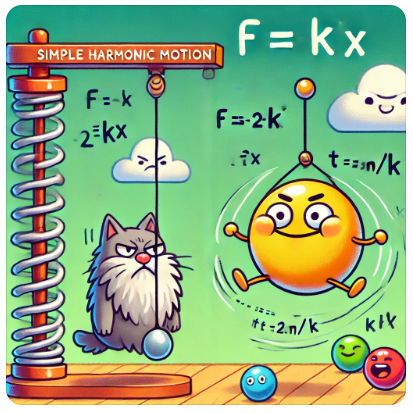Unit 6 Overview: Simple Harmonic Motion
With the fundamentals of forces and energy covered in previous units, Unit 6 introduces Simple Harmonic Motion (SHM) – a unique and periodic type of motion observed in systems like pendulums and springs. In this unit, we focus on describing the energy transformations, forces, accelerations, and velocities of oscillating systems, and exploring their practical applications. SHM topics constitute approximately 2-4% of the AP Physics 1 exam.
Applicable Big Ideas
Big Idea #3: Force Interactions
The interactions of an object with other objects can be described by forces.Big Idea #5: Conservation
Changes that occur as a result of interactions are constrained by conservation laws.
Key Concepts
Period (T): The time taken to complete one oscillation.
Amplitude: The maximum displacement from the equilibrium position.
Frequency (f): The number of oscillations per unit time.
Equilibrium Point: The position where the net force on the system is zero.
Kinetic Energy (K): Energy due to motion.
Potential Energy (U): Energy due to position, including gravitational (Ug) and elastic potential energy (Usp).
6.1 Period of Simple Harmonic Oscillators
A Simple Harmonic Oscillator (SHO) is a system that oscillates repeatedly with a fixed frequency and amplitude. Common examples include:
A swinging pendulum.
A spring stretched and released.
A mass oscillating around a fixed point.
Hooke’s Law and SHM
SHOs follow Hooke’s Law, which states: Where:
F is the restoring force,
k is the spring constant,
x is the displacement from the equilibrium position.
The negative sign indicates that the force is always directed towards the equilibrium point. This relationship creates periodic motion.
Period of Oscillation
The period (T) of an SHO is the time required for one complete oscillation. It depends on the mass (m) and the spring constant (k) of the system and can be calculated using: Where:
T = Period (seconds),
m = Mass (kg),
k = Spring constant (N/m).
Practical Implications
Knowing the period helps predict the motion of oscillating systems in engineering, architecture, and natural phenomena, such as vibrations and waves.
6.2 Energy of a Simple Harmonic Oscillator
In SHM, energy oscillates between kinetic energy (K) and potential energy (U). The total mechanical energy of the system remains constant, provided no external forces (like friction) act on it.
Kinetic Energy (K)
The kinetic energy of an SHO is: Where:
m = Mass of the object,
v = Velocity.
Kinetic energy is maximum when the object passes through the equilibrium point, as its velocity is greatest.
Potential Energy (U)
For a spring in SHM, the potential energy is: Where:
k = Spring constant,
x = Displacement from the equilibrium position.
Potential energy is maximum when the object is farthest from equilibrium (i.e., at maximum displacement).
Conservation of Energy
The total energy (E) of an SHO is: This value remains constant:
At the equilibrium point:
At maximum displacement:
Energy Transformations
As the object oscillates:
Kinetic energy converts into potential energy and vice versa.
The total energy oscillates between its kinetic and potential forms without loss, assuming no damping.







